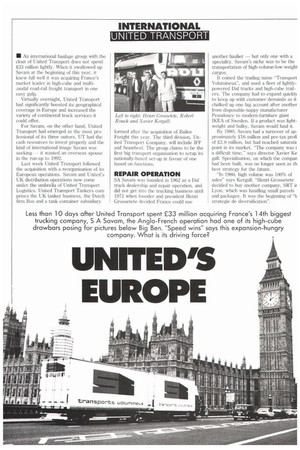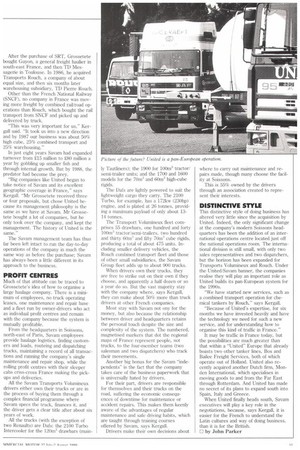UNITED'S EUROPE
Page 50

Page 51

If you've noticed an error in this article please click here to report it so we can fix it.
Less than 10 days after United Transport spent £33 million acquiring France's 14th biggest trucking company, S A Savam, the Anglo-French operation had one of its high-cube drawbars posing for pictures below Big Ben. "Speed wins" says this expansion-hungry company. What is its driving force?
• An international haulage group with the clout of United Transport does not spend £33 million lightly. When it swallowed up Savam at the beginning of this year, it knew full well it was acquiring France's market leader in high-cube and multimodal road-rail freight transport in one easy gulp.
Virtually overnight., United Transport had significantly boosted its geographical coverage in Europe and increased the variety of continental truck services it could offer.
For Savam, on the other hand, United Transport had emerged as the most professional of its three suitors. UT had the cash resources to invest properly and the kind of international image Savam was seeking — it wanted an overseas spouse in the run-up to 1992.
Last week United Transport followed the acquisition with a reorganisation of its European operations. Savant and United's UK distribution operations now come under the umbrella of United Transport Logistics. United Transport Tankers comprises the UK tanker business, the Dutch firm Bos and a tank container subsidiary formed after the acquisition of Bailee Freight this year. The third division, United Transport Company, will include IFF and Seawheel. The group claims to be the first big transport organisation to scrap its nationally-based set-up in favour of one based on functions.
REPAIR OPERATION
SA Savam was founded in 1962 as a Daf truck dealership and repair operation, and did not get into the trucking business until 1971 when founder and president Henri Grossetete derided France could use another haulier — but only one with a speciality. Savam's niche was to be the transportation of high-volumeilow-weighl cargos.
It coined the trading name -Transport Volumineux", and used a fleet of lightlypowered Daf trucks and high-cube trailers. The company had to expand quickly to keep up with customer demands as it chalked up one big account after another from disposable-nappy manufacturer Peaudouce to modern-furniture giant IKEA of Sweden. If a product was lightweight and bulky. Savam would haul it.
By 1980, Savant had a turnover of approximately £16 million and pre-tax profi of £2.8 million, but had reached saturatir point in its market. "The company was a difficult time," says director Xavier Ke gall. Specialisation, on which the compan had been built, was no longer seen as th best strategy for the future.
"In 1980, high volume was 100% of sales" says Kergall. "Henri Grossetete decided to buy another company, SRT ir Lyon, which was handling small parcels and packages. It was the beginning of "li strategie de diversification". After the purchase of SRT, Grossetete bought Guyon, a general freight haulier in south-east France, and then TD Messagerie in Toulouse. In 1986, he acquired Transports Rouch, a company of about equal size, and then six months later warehousing subsidiary, TD Pierre Rouch.
Other than the French National Railway (SNCF), no company in France was moving more freight by combined rail/road operations than Rouch, which bought the rail transport from SNCF and picked up and delivered by truck.
"This was very important for us," Kergall said. "It took us into a new direction and by 1987 our business was about 50% high cube, 25% combined transport and 25% warehousing."
In just eight years Savam had expanded turnover from 215 million to 280 million a year by gobbling up smaller fish and through internal growth. But by 1988, the predator had become the prey.
"Big companies like United began to take notice of Savam and its excellent geographic coverage in France," says Kergall. "Mr Grossetete received three or four proposals, but chose United because its management philosophy is the same as we have at Savam. Mr Grossetete bought a lot of companies, but he only took over the company, and kept the management. The history of United is the same."
The Savam management team has thus far been left intact to run the day-to-day operations of the company in much the same way as before the purchase; Savam has always been a little different in its approach to the business.
PROFIT CENTRES
Much of that attitude can be traced to Grossetete's idea of how to organise a large haulage company. There is a minimum of employees, no truck operating leases, one maintenance and repair base and a fleet run by owner-drivers who act as individual profit centres and remain with the company because the system is mutually profitable.
From the headquarters in Soissons, north-east of Paris, Savam employees provide haulage logistics, finding customers and loads, routeing and dispatching trucks, maintaining a record of all transactions and running the company's single maintenance and repair shop, while the rolling profit centres with their sleeper cabs criss-cross France making the pickups and deliveries.
All the Savam Transports Volumineux drivers either own their trucks or are in the process of buying them through a complex financial programme where Savam specs the truck, finances it, and the driver gets a clear title after about six years of work.
All the trucks (with the exception of two Renaults) are Dafs: the 2100 Turbo Interco°ler for the 120m3 drawbars (main ly Tautliners); the 1900 for 100m3 tractor/ semi-trailer units; and the 1700 and 16011 models for the 70m.' and 60m3 high-cube rigids.
The Dafs are lightly powered to suit the lightweight cargo they carry. The 2100 Turbo, for example, has a I72kw (230hp) engine, and is plated at 26 tonnes, providing a maximum payload of only about 1314 tonnes.
The Transport Volumineux fleet comprises 55 drawbars, one hundred and forty 100011 tractor/semi-trailers, two hundred and thirty 60m" and fifty 70m3 cube rigids, producing a total of about 475 units. Including smaller delivery vehicles, the Rouch combined transport fleet and those of other small subsidiaries, the Savam Group fleet adds up to about 900 trucks.
When drivers own their trucks, they are free to strike out on their own if they choose, and apparently a half dozen or so a year do so. But the vast majority stay with the company where. says Kergall, they can make about 50% more than truck drivers at other French companies.
Most stay with Savam not ony for the money, but also because the relationship between driver and headquarters retains the personal touch despite the size and complexity of the system. The numbered. magnetised markers that dot the regional maps of France represent people, not trucks, to the four-member teams (two salesman and two dispatchers) who track their movements.
Another big bonus for the Savam "independents" is the fact that the company takes care of the business paperwork that is universally hated by drivers.
For their part, drivers are responsible for themselves and their trucks on the road, suffering the economic consequences of downtime for maintenance or accident repairs. This makes them keenly aware of the advantages of regular maintenance and safe driving habits, which are taught through training courses offered by Savam, says Kergall.
Drivers make their own decisions about where to carry out maintenance and repairs made, though many choose the facility at Soissons.
This is 55% owned by the drivers through an association created to represent their interests.
DISTINCTIVE STYLE
This distinctive style of doing business has altered very little since the acquisition by United. Indeed, the only significant change at the company's modern Soissons headquarters has been the addition of an international operations centre located just off the national operations room. The international division is still small, with only two sales representatives and two dispatchers, but the horizon has been expanded for Transports Volumineux and Rouch. Under the United/Savam banner, the companies realise they will play an important role as United builds its pan-European system for the 1990s.
"We have started new services, such as a combined transport operation for chemical tankers by Rouch," says Kergall.
"Because of United's expertise, for six months we have invested heavily and have the technology we need for such a new service, and for understanding how to organise this kind of traffic in France."
It may be traffic in France today, but the possibilities are much greater than that within a "United" Europe that already boasts two other tanker lines, Bos and Bailee Freight Services, both of which operate out of Holland. United also recently acquired another Dutch firm, Monden International, which specialises in moving goods to and from the Far East through Rotterdam. And United has made no secret of its plans to expand south into Spain, Italy and Greece.
When United finally heads south, Savam executives will play a key role in the negotiations, because, says Kergall, it is easier for the French to understand the Latin cultures and way of doing business, than it is for the British.
0 by John Parker




































































































































